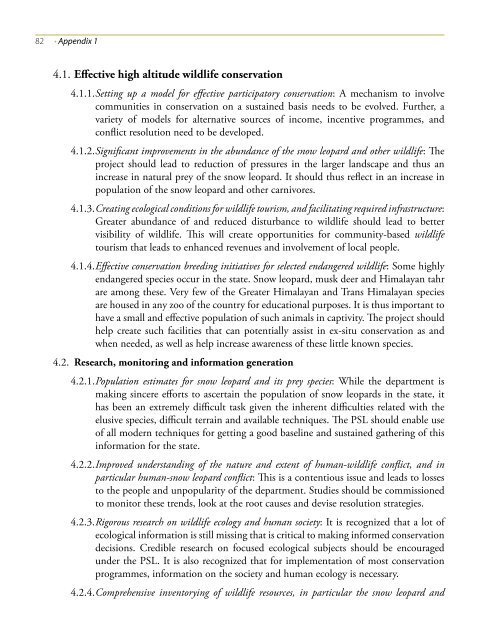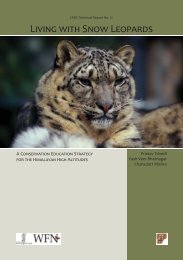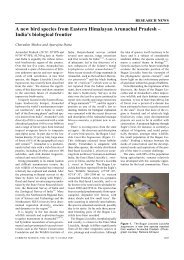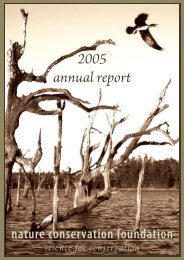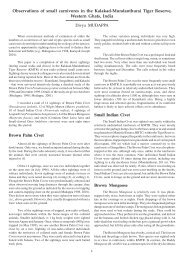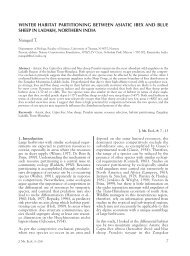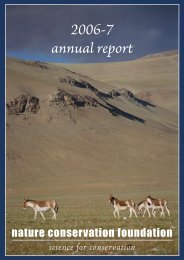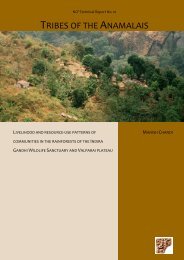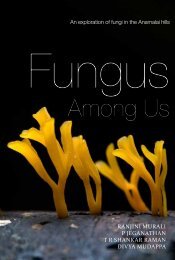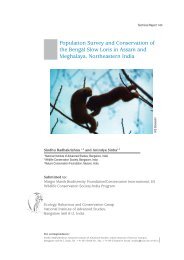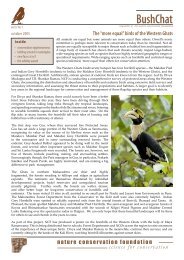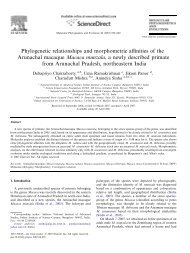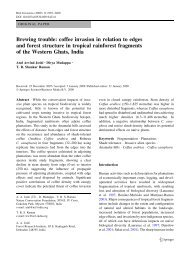towards project snow leopard - Nature Conservation Foundation
towards project snow leopard - Nature Conservation Foundation
towards project snow leopard - Nature Conservation Foundation
Create successful ePaper yourself
Turn your PDF publications into a flip-book with our unique Google optimized e-Paper software.
82 • Appendix 1<br />
4.1. Effective high altitude wildlife conservation<br />
4.1.1. Setting up a model for effective participatory conservation: A mechanism to involve<br />
communities in conservation on a sustained basis needs to be evolved. Further, a<br />
variety of models for alternative sources of income, incentive programmes, and<br />
conflict resolution need to be developed.<br />
4.1.2. Significant improvements in the abundance of the <strong>snow</strong> <strong>leopard</strong> and other wildlife: The<br />
<strong>project</strong> should lead to reduction of pressures in the larger landscape and thus an<br />
increase in natural prey of the <strong>snow</strong> <strong>leopard</strong>. It should thus reflect in an increase in<br />
population of the <strong>snow</strong> <strong>leopard</strong> and other carnivores.<br />
4.1.3. Creating ecological conditions for wildlife tourism, and facilitating required infrastructure:<br />
Greater abundance of and reduced disturbance to wildlife should lead to better<br />
visibility of wildlife. This will create opportunities for community-based wildlife<br />
tourism that leads to enhanced revenues and involvement of local people.<br />
4.1.4. Effective conservation breeding initiatives for selected endangered wildlife: Some highly<br />
endangered species occur in the state. Snow <strong>leopard</strong>, musk deer and Himalayan tahr<br />
are among these. Very few of the Greater Himalayan and Trans Himalayan species<br />
are housed in any zoo of the country for educational purposes. It is thus important to<br />
have a small and effective population of such animals in captivity. The <strong>project</strong> should<br />
help create such facilities that can potentially assist in ex-situ conservation as and<br />
when needed, as well as help increase awareness of these little known species.<br />
4.2. Research, monitoring and information generation<br />
4.2.1. Population estimates for <strong>snow</strong> <strong>leopard</strong> and its prey species: While the department is<br />
making sincere efforts to ascertain the population of <strong>snow</strong> <strong>leopard</strong>s in the state, it<br />
has been an extremely difficult task given the inherent difficulties related with the<br />
elusive species, difficult terrain and available techniques. The PSL should enable use<br />
of all modern techniques for getting a good baseline and sustained gathering of this<br />
information for the state.<br />
4.2.2. Improved understanding of the nature and extent of human-wildlife conflict, and in<br />
particular human-<strong>snow</strong> <strong>leopard</strong> conflict: This is a contentious issue and leads to losses<br />
to the people and unpopularity of the department. Studies should be commissioned<br />
to monitor these trends, look at the root causes and devise resolution strategies.<br />
4.2.3. Rigorous research on wildlife ecology and human society: It is recognized that a lot of<br />
ecological information is still missing that is critical to making informed conservation<br />
decisions. Credible research on focused ecological subjects should be encouraged<br />
under the PSL. It is also recognized that for implementation of most conservation<br />
programmes, information on the society and human ecology is necessary.<br />
4.2.4. Comprehensive inventorying of wildlife resources, in particular the <strong>snow</strong> <strong>leopard</strong> and


